water temperature
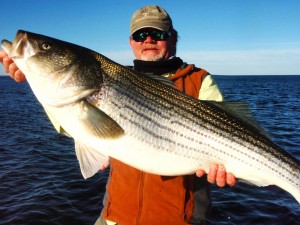 If the next 51 weeks of 2012 go as well as the first one, this promises to be a very good year for light tackle fishing on the Chesapeake Bay. I’ve fished four times and caught a Diamond Jim qualifying citation fish on each trip including three rockfish in the mid 40-inch range. I’m chalking it up to a little experience, some insider information, and a lot of luck. My son, “Big Fish Cory” has been visiting. Although he didn’t catch any trophies this time around, he still brought along his lucky horseshoe. Chesapeake striped bass fishermen have two basic winter options. One is to fish deep holes – either in the main stem of the Bay or up in the outside bends of the rivers – and the other is to work the warm water discharges. Since we’ve had a very mild winter so far, the warm water discharges have been inconsistent. I decided to split the difference and fish the last four days close to home off Kent Island.
If the next 51 weeks of 2012 go as well as the first one, this promises to be a very good year for light tackle fishing on the Chesapeake Bay. I’ve fished four times and caught a Diamond Jim qualifying citation fish on each trip including three rockfish in the mid 40-inch range. I’m chalking it up to a little experience, some insider information, and a lot of luck. My son, “Big Fish Cory” has been visiting. Although he didn’t catch any trophies this time around, he still brought along his lucky horseshoe. Chesapeake striped bass fishermen have two basic winter options. One is to fish deep holes – either in the main stem of the Bay or up in the outside bends of the rivers – and the other is to work the warm water discharges. Since we’ve had a very mild winter so far, the warm water discharges have been inconsistent. I decided to split the difference and fish the last four days close to home off Kent Island.
One of the best places I know of to jig up deep water rockfish is the Bay Bridge. Two- and three-year-old-stripers and white perch survive the cold winter by stacking up around the Bay Bridge rock piles. They’ll stay there until the spring freshet washes out their warm water comfort zones. Even though they are readily apparent on a fish finder, they aren’t always easy to catch. To coax a strike out of deep-water stripers you just have to aggravate them until they bite. You can jig for hours and not get a single strike, then, snap – the fish will turn on and you’re catching every cast. Read More!
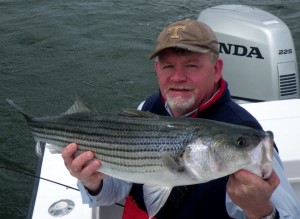 So far, it’s been a disappointing fall for Chesapeake Bay striper fishing. There are a few fish to be caught, but it usually takes a lot of time and fuel dollars to find them. I spent a few minutes last night going over my logs from the past four years. This November’s fishing has been the poorest I’ve seen since I started fishing the Chesapeake. I think there are several reasons, first and foremost is lack of bait. We already know that menhaden have been over-harvested to the point where they are only a small fraction of what they should be, and we know that striped bass populations are down, but I think our biggest problem this fall is fresh water.
So far, it’s been a disappointing fall for Chesapeake Bay striper fishing. There are a few fish to be caught, but it usually takes a lot of time and fuel dollars to find them. I spent a few minutes last night going over my logs from the past four years. This November’s fishing has been the poorest I’ve seen since I started fishing the Chesapeake. I think there are several reasons, first and foremost is lack of bait. We already know that menhaden have been over-harvested to the point where they are only a small fraction of what they should be, and we know that striped bass populations are down, but I think our biggest problem this fall is fresh water.
Last week, the Maryland Department of Natural Resources reported big problems with Upper Bay oysters. As part of a Bay-wide survey, biologists collected samples from 15 individual oyster bars north of the Bay Bridge. In the four northernmost bars along the Eastern Shore, oysters suffered a cumulative mortality of 79 percent, with no live oysters on the two northernmost bars. The few live oysters that were found in upper Bay bars were in poor condition — bloated, watery and translucent — and mortalities may continue for some time. Biologists believe the high mortality was caused by the lack of salinity in the upper Bay from March through July, 2011. During that period many modern day records were broken for high flow and low salinity. Read More!
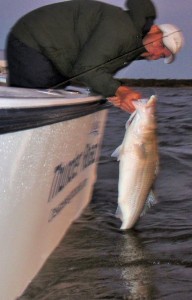 Since I’ve reported bigger fish on recent trips, I’ve been overwhelmed with questions from fishermen who want to know where the fish are. The big fish are moving around very quickly and they are rarely at the same place twice. Even on days when I find them right back where I left them, they’ve been very wary and hard to catch. It’s been a challenging season, but if you look at my mid-October fishing reports from last year, you’ll see that the pattern is nearly the same. I think we sometimes put too much emphasis on locations, and not enough on patterns. Tell someone where to go to catch a fish and you may help them for a day, but teach them how to identify specific patterns in how fish behave, and you’ve helped them for a lifetime. Ask any accomplished fisherman the secret to repeated success and he’ll tell you it’s the ability to identify specific feeding patterns. I believe that you can drop a good fisherman into any body of water in the world and he’ll catch fish as long as you give him enough time to recognize the prevailing pattern. It’s especially important on the Chesapeake where circumstances change quickly and rapid drops in water temperature are not unusual in October. I think fishing conditions shift faster and more often here than anywhere I’ve fished before. Fortunately, fish are creatures of habit and there are distinct patterns to their behavior.
Since I’ve reported bigger fish on recent trips, I’ve been overwhelmed with questions from fishermen who want to know where the fish are. The big fish are moving around very quickly and they are rarely at the same place twice. Even on days when I find them right back where I left them, they’ve been very wary and hard to catch. It’s been a challenging season, but if you look at my mid-October fishing reports from last year, you’ll see that the pattern is nearly the same. I think we sometimes put too much emphasis on locations, and not enough on patterns. Tell someone where to go to catch a fish and you may help them for a day, but teach them how to identify specific patterns in how fish behave, and you’ve helped them for a lifetime. Ask any accomplished fisherman the secret to repeated success and he’ll tell you it’s the ability to identify specific feeding patterns. I believe that you can drop a good fisherman into any body of water in the world and he’ll catch fish as long as you give him enough time to recognize the prevailing pattern. It’s especially important on the Chesapeake where circumstances change quickly and rapid drops in water temperature are not unusual in October. I think fishing conditions shift faster and more often here than anywhere I’ve fished before. Fortunately, fish are creatures of habit and there are distinct patterns to their behavior.
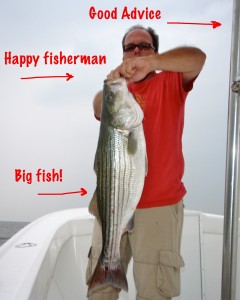 No man, after catching a big fish, goes home through an alley. – Ancient Chinese Proverb
No man, after catching a big fish, goes home through an alley. – Ancient Chinese Proverb
Maybe you’ve heard someone recite another old saying about “the three stages of a fisherman’s life.” It goes something like this: The first stage is when the angler’s main objective is to catch as many fish as possible, the second stage is when the angler only searches for the larger fish, and the third and final stage is when size doesn’t matter and the capture is unimportant, but satisfaction comes from the way the angler tricks the fish. I usually nod my head in agreement when I hear that, but c’mon now, I don’t know one single fisherman who, when given a choice, doesn’t cast toward the biggest fish in the pond. We can wax poetic about the joys of baptizing ourselves in the boundless beauty of nature, and we can sing the praises of that peaceful solitude we find out on the open water, but screw it – the bottom line is, no matter how we are fishing, we want to catch a whopper! In this third and final segment of the Gimme a Breaker series, we’re looking at ways to get the lunkers out of surface blitzing Chesapeake rockfish. Read More!
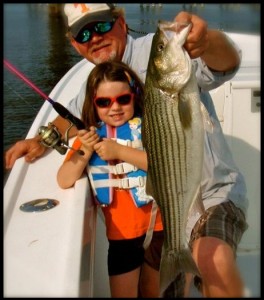 I recently found some old pictures of myself in diapers, standing beside a small wooden boat parked in front of a Tennessee farmhouse. Towering above me was my father, and at my bare feet was a nice stringer of fat largemouth bass. Did I catch them? Probably not, but like any good fisherman, I’ll happily take the credit. I might even tell you a tall tale about how – at the ripe old age of two – I tricked them into biting a lure that I hand carved from a boar’s tusk with a Bowie knife, and how they pulled harder than a Smoky Mountain mule.
I recently found some old pictures of myself in diapers, standing beside a small wooden boat parked in front of a Tennessee farmhouse. Towering above me was my father, and at my bare feet was a nice stringer of fat largemouth bass. Did I catch them? Probably not, but like any good fisherman, I’ll happily take the credit. I might even tell you a tall tale about how – at the ripe old age of two – I tricked them into biting a lure that I hand carved from a boar’s tusk with a Bowie knife, and how they pulled harder than a Smoky Mountain mule.
There’s no doubt that I owe much of what I know about fishing to my father. There’s nothing better than fishing with family. All three of my sons have become first-class fishermen. This week I’ve been fishing with my family’s next generation of anglers. I’ve had a great time on the water with my son Daniel and my granddaughter Ella. I’m happy to report that Chesapeake Bay salinity levels are finally climbing back toward normal levels (see chart below), although they’re still low. Since conditions are stablizing, striped bass fishing is getting a little more reliable. That isn’t to say some days aren’t better than others, but we’re at the point where I at least think we can count on a few fish on any given outing.
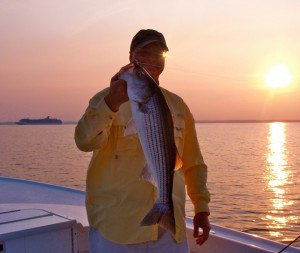 Channel catfish at Hackett’s Bar, carp at the Bay Bridge, snakeheads in St. Jerome’s Creek, and very few stripers in their usual haunts around Kent Island – what’s up with all this late-spring craziness in the Chesapeake Bay? Most fishermen are blaming salt, or more specifically, a lack thereof. Very wet weather in the Susquehanna River watershed has meant lots of fresh water entering the Bay. It’s highly unusual for the Bay to be this fresh in June. Some stations are reporting the lowest readings in recorded history. Salinity is expressed in parts per thousand (ppt), in other words, the number of grams of dissolved salts present in 1,000 grams of water. The water in the Atlantic Ocean is about 35 ppt. Surface salinity today at the Gooses Reef Buoy in the Mid-Chesapeake Bay is 2.0 ppt. That’s low! For better striped bass fishing, we need more salt.
Channel catfish at Hackett’s Bar, carp at the Bay Bridge, snakeheads in St. Jerome’s Creek, and very few stripers in their usual haunts around Kent Island – what’s up with all this late-spring craziness in the Chesapeake Bay? Most fishermen are blaming salt, or more specifically, a lack thereof. Very wet weather in the Susquehanna River watershed has meant lots of fresh water entering the Bay. It’s highly unusual for the Bay to be this fresh in June. Some stations are reporting the lowest readings in recorded history. Salinity is expressed in parts per thousand (ppt), in other words, the number of grams of dissolved salts present in 1,000 grams of water. The water in the Atlantic Ocean is about 35 ppt. Surface salinity today at the Gooses Reef Buoy in the Mid-Chesapeake Bay is 2.0 ppt. That’s low! For better striped bass fishing, we need more salt.
Fishermen have long recognized the importance of locating comfort zones where fish prefer to stay, but sometimes that isn’t so easy. Fishing in late May and early June is usually a challenge, but low salinity levels have made it especially difficult this year. Complicating the matter is that he water can be a lot saltier on the bottom of the Bay than it is on top this time of year. Since, in addition to surface observations, The Gooses Reef Buoy also provides salinity readings from the bottom of the Bay, we can see that it’s currently 7.1 ppt. That’s over three times saltier than it is on the surface. Read More!


